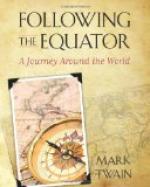Finally the quartz lodes were attacked. That is not poor-man’s mining. Quartz-mining and milling require capital, and staying-power, and patience. Big companies were formed, and for several decades, now, the lodes have been successfully worked, and have yielded great wealth. Since the gold discovery in 1853 the Ballarat mines—taking the three kinds of mining together—have contributed to the world’s pocket something over three hundred millions of dollars, which is to say that this nearly invisible little spot on the earth’s surface has yielded about one-fourth as much gold in forty-four years as all California has yielded in forty-seven. The Californian aggregate, from 1848 to 1895, inclusive, as reported by the Statistician of the United States Mint, is $1,265,215,217.
A citizen told me a curious thing about those mines. With all my experience of mining I had never heard of anything of the sort before. The main gold reef runs about north and south—of course for that is the custom of a rich gold reef. At Ballarat its course is between walls of slate. Now the citizen told me that throughout a stretch of twelve miles along the reef, the reef is crossed at intervals by a straight black streak of a carbonaceous nature—a streak in the slate; a streak no thicker than a pencil—and that wherever it crosses the reef you will certainly find gold at the junction. It is called the Indicator. Thirty feet on each side of the Indicator (and down in the slate, of course) is a still finer streak—a streak as fine as a pencil mark; and indeed, that is its name Pencil Mark. Whenever you find the Pencil Mark you know that thirty feet from it is the Indicator; you measure the distance, excavate, find the Indicator, trace it straight to the reef, and sink your shaft; your fortune is made, for certain. If that is true, it is curious. And it is curious anyway.
Ballarat is a town of only 40,000 population; and yet, since it is in Australia, it has every essential of an advanced and enlightened big city. This is pure matter of course. I must stop dwelling upon these things. It is hard to keep from dwelling upon them, though; for it is difficult to get away from the surprise of it. I will let the other details go, this time, but I must allow myself to mention that this little town has a park of 326 acres; a flower garden of 83 acres, with an elaborate and expensive fernery in it and some costly and unusually fine statuary; and an artificial lake covering 600 acres, equipped with a fleet of 200 shells, small sail boats, and little steam yachts.
At this point I strike out some other praiseful things which I was tempted to add. I do not strike them out because they were not true or not well said, but because I find them better said by another man—and a man more competent to testify, too, because he belongs on the ground, and knows. I clip them from a chatty speech delivered some years ago by Mr. William Little, who was at that time mayor of Ballarat:




